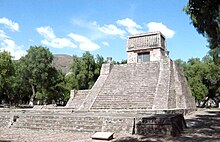151:
236:
199:
24:
218:. The construction method was probably the characteristic one of successive structures, one on top of the other, and at least four successive time periods have been detected. Today, the inside of the pyramid is one of the best preserved interior structures. The exterior structures were removed and many of their stones were used to build the adjacent church, which dates back to the late 16th century. In 1962, the architect and archaeologist
254:
which was once adjacent to the site and which now houses the museum. Dávalos dedicated part of his life to collecting the artifacts now on display. His collection includes ceramic and stone materials from this and other sites in the Mexica zone of influence. The museum also exhibits a kitchen and
222:
reconstructed and reinforced the pyramid's basement and rebuilt the temple that crowns it. Although such a reconstruction certainly does not comply with current canons of archaeology, the product is a beautifully delineated
327:
210:'s main structures. It consists of a large staircase leading up to a temple. Like Tenayuca, it is thought that the temple was dedicated to the worship of
49:
247:
operates an on site museum called the
Eusebio Davalos Hurtado Museum of Mexica Sculpture. Eusebio Dávalos an archaeologist and the owner of the
162:, the political and religious center of the time; the two sites are about 3 km apart. Along with Tenayuca, it was later annexed by the
337:
332:
183:
268:
342:
190:
structures, was dismantled, its stone forming the basis of the new city's churches, houses, and monuments.
317:
302:
295:
219:
224:
154:
Parish of Santa
Cecelia Acatitlan built partially with materials from the destroyed pyramid.
322:
8:
207:
123:
37:
256:
135:
114:: "place among the reeds"; Spanish "carrizal") is an archeological zone of the early
89:
206:
Only one quadrangular basement currently survives, which might have been one of the
171:
211:
127:
150:
311:
64:
51:
235:
198:
179:
175:
139:
23:
187:
131:
122:) culture located in the town of Santa Cecilia, in the municipality of
99:
298:
Foundation for the
Advancement of Mesoamerican Studies, Inc. 145 pp.
259:. The museum is located on Calle Circuito Pirámide in Tlalnepantla.
251:
159:
111:
248:
215:
163:
119:
115:
284:. Instituto Nacional de Antropología e Historia , Mexico 1977.
186:, Acatitlan began to decline, and the city, like many other
244:
167:
138:
times, it was located on the northwest shore of the great
282:
La escultura Mexica del Museo de Santa
Cecilia Acatitlán
227:, one of the best-conserved examples of this culture.
255:living room in the style of the period before the
309:
239:Sta Cecilia Acatitlan pyramid, looking north
328:Archaeological sites in the State of Mexico
22:
234:
197:
149:
310:
193:
158:This settlement was associated with
13:
303:Tlalnepantla - The Land In-Between
288:
14:
354:
338:Archaeological museums in Mexico
130:, about 10 km northwest of
333:Museums in the State of Mexico
1:
274:
269:List of Mesoamerican pyramids
145:
28:Main staircase of the pyramid
7:
262:
178:, until the arrival of the
10:
359:
230:
95:
85:
80:
43:
33:
21:
301:Bacon, Jeffrey R. 2004.
296:Aztec architecture (PDF)
294:Aguilar-Moreno, Manuel.
166:and became part of the
65:19.5525833°N 99.17333°W
17:Santa Cecilia Acatitlan
240:
220:Eduardo Pareyon Moreno
203:
155:
243:Inaugurated in 1961,
238:
201:
153:
70:19.5525833; -99.17333
343:Tlalnepantla de Baz
280:SOLIS OLGUIN, F.R.
194:Archaeological site
182:in 1521. After the
124:Tlalnepantla de Baz
61: /
38:Tlalnepantla de Baz
18:
318:Pyramids in Mexico
257:Mexican Revolution
241:
204:
184:conquest of Mexico
174:under the rule of
156:
16:
105:
104:
350:
172:Valley of Mexico
90:Late Postclassic
76:
75:
73:
72:
71:
66:
62:
59:
58:
57:
54:
26:
19:
15:
358:
357:
353:
352:
351:
349:
348:
347:
308:
307:
291:
289:Further reading
277:
265:
233:
212:Huitzilopochtli
196:
170:culture of the
148:
128:State of Mexico
69:
67:
63:
60:
55:
52:
50:
48:
47:
29:
12:
11:
5:
356:
346:
345:
340:
335:
330:
325:
320:
306:
305:
299:
290:
287:
286:
285:
276:
273:
272:
271:
264:
261:
232:
229:
225:Mexica pyramid
195:
192:
147:
144:
103:
102:
97:
93:
92:
87:
83:
82:
78:
77:
45:
41:
40:
35:
31:
30:
27:
9:
6:
4:
3:
2:
355:
344:
341:
339:
336:
334:
331:
329:
326:
324:
321:
319:
316:
315:
313:
304:
300:
297:
293:
292:
283:
279:
278:
270:
267:
266:
260:
258:
253:
250:
246:
237:
228:
226:
221:
217:
213:
209:
200:
191:
189:
185:
181:
180:conquistadors
177:
173:
169:
165:
161:
152:
143:
141:
137:
136:pre-Columbian
133:
129:
125:
121:
117:
113:
109:
101:
98:
94:
91:
88:
84:
79:
74:
53:19°33′09.30″N
46:
42:
39:
36:
32:
25:
20:
281:
242:
205:
188:Mesoamerican
176:Tenochtitlan
157:
140:Lake Texcoco
107:
106:
323:Aztec sites
202:The pyramid
132:Mexico City
68: /
44:Coordinates
312:Categories
275:References
168:lacustrine
146:Foundation
118:(or early
100:Chichimeca
56:99°10′24″W
108:Acatitlan
263:See also
252:hacienda
160:Tenayuca
96:Cultures
34:Location
126:in the
112:Nahuatl
86:Periods
81:History
249:pulque
231:Museum
216:Tlaloc
164:Mexica
120:Toltec
134:. In
116:Aztec
245:INAH
214:and
208:site
314::
142:.
110:(
Text is available under the Creative Commons Attribution-ShareAlike License. Additional terms may apply.



